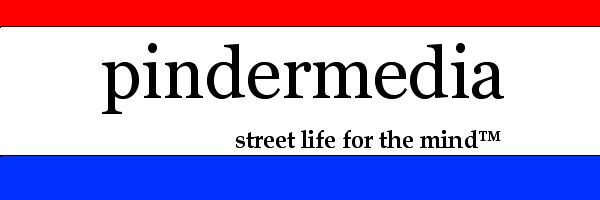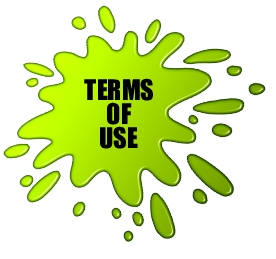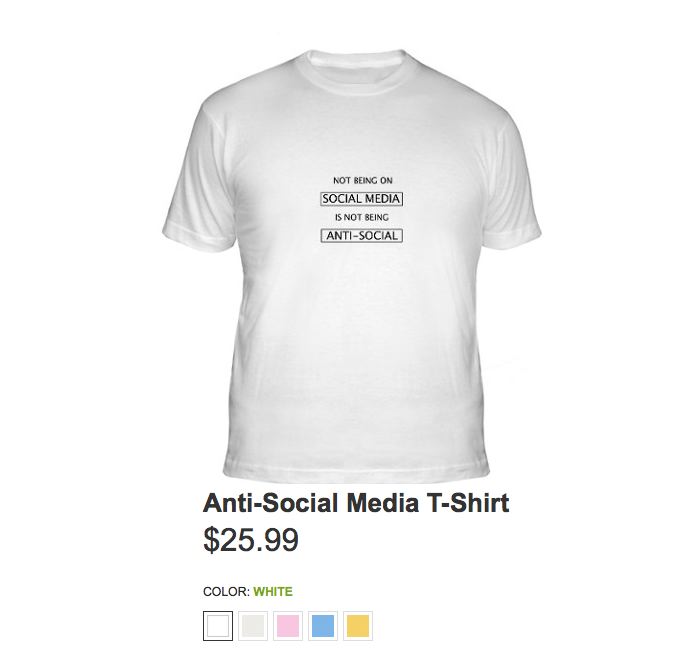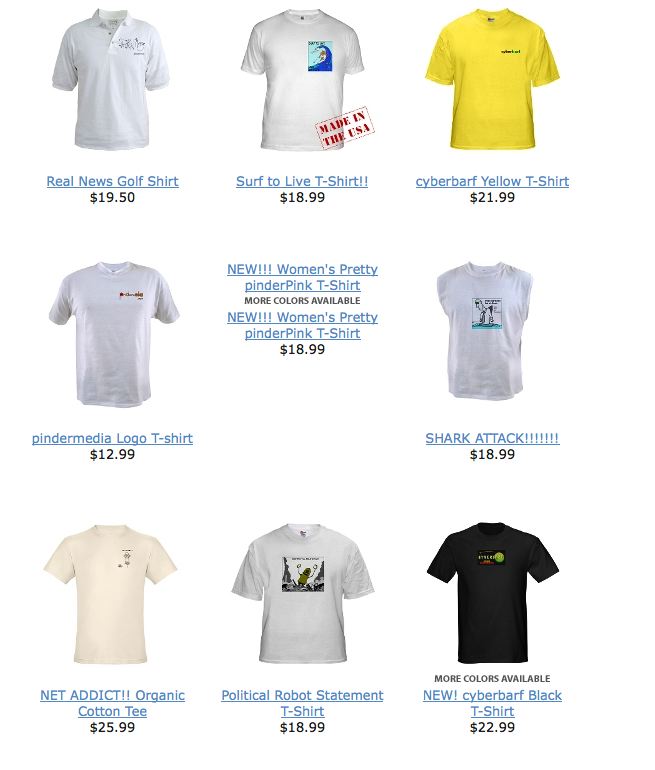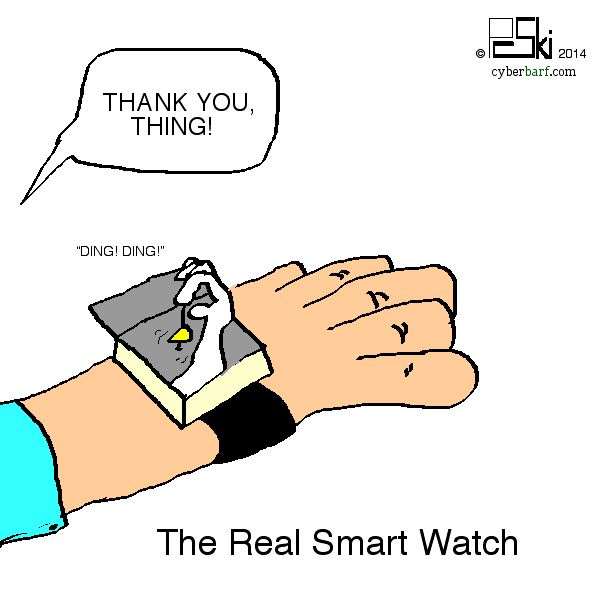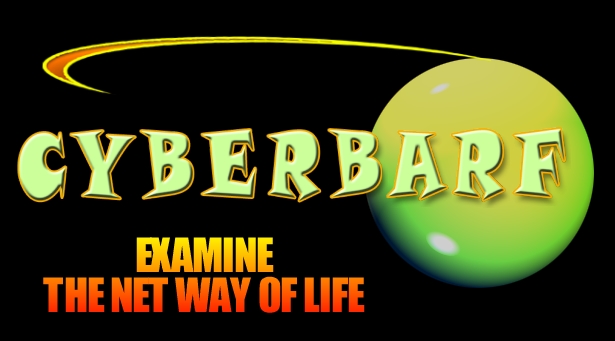|
cyberbarf VOLUME 13 NO. 10 EXAMINE THE NET WAY OF LIFE MAY, 2014
THE AGE OF MISINFORMATION PATENT SYSTEM FIX BARFETTES FACEBOOK DATA RULES iTOONS WHETHER REPORT NEW REAL NEWS KOMIX! SHOW HACK!
|
|
cyberbarf EXAMINE THE NET WAY OF LIFE
QUICK & RELIABLE SERVICE
CYBERBARF T-SHIRTS, MUGS & MORE
THANK YOU FOR YOUR SUPPORT!
CYBERBARF
PRICES TO SUBJECT TO CHANGE PLEASE REVIEW E-STORE SITE FOR CURRENT SALES
|
|
cyberbarf EXAMINE THE NET WAY OF LIFE cyberbarf THE AGE OF MISINFORMATION ESSAY When the Malaysian airplane, Flight 370, did not make it to its destination on March 8, 2014, it was a tragic loss of human life. The plane vanished off commercial radar and radio frequencies. The frantic search led to rampant speculation, misinformation and distrust among all the parties involved, including regional governments, the victim's families and the global news media. When a prime time weekend anchor at CNN asks a panel of experts whether the missing flight could be solved by some supernatural explanation, an aviation expert replied that a) a small black hole would have destroyed our universe so that is not an answer; b) the Bermuda Triangle is mostly a weather related incidents; and c) LOST was just a television show. Indeed. At that moment, broadcast journalism had jumped the shark. The only fact anyone had was that Flight 370 did not make it to its destination, Beijing. Other than that fact, what happened to the aircraft, the crew and the passengers was unknown. That lone truth is the only concrete fact since no one has found or confirmed any aircraft, plane debris, or distress signals. The amount of misinformation is directly proportional to the amount of airtime needed to be filled by 24/7 news organizations. When anchors preface their questions early on, “we don't know what happened to flight 370, ” but then ask a source to discuss “what could have happened” is not reporting on a news event - - - but baiting speculation in order to retain audience ratings. Despite CNN's speculative nonsense, its ratings did go up dramatically. It was no longer news, but more like a television mystery show script pitch session. One should not be surprised that news has become a form of entertainment. When American politics became so polarized and sleazy, opinions were more important than actual facts because opinions were easier to find and harder to rebut. As such, both government agencies, politicians and corporations churn out their own levels of misinformation in order to look better to the general public. Public relations and incumbency soundbites rule the airwaves. This won't change because the whole cottage industry has become quite profitable.
Every new lead in the Flight 370 story has turned into another wave of misinformation wrapped in verbiage of hope. There are some information that one can glean from the new leads that turn into nothing: first, the Indian Ocean is a violent, churning environment of high seas and tough weather conditions which makes searching the vast expanse almost impossible; second, the world's oceans are liquid landfills with tons of floating debris from coastal cities, container ships and boating accidents; third, under the seas is a noisy place according to oceanographers who say ocean waves, gas releases, wildlife noises can be as muffled as black box pings; and lastly, with all the high tech tracking, defense and spy satellite data available to countries, the political mistrust between nations in the search regions has been greater than the need to rescue or recover the human lives aboard 370. At this time, there is no reason to believe that the search efforts have been in focused on the right area. The plane's last heading according to its flight plan was to head toward Vietnam. The original search area in the days after the plane lost contact was in the waters between Malaysia and Vietnam. But that common sense approach of extending the fuel capacity time line towards China (for inland jungle searches) was abandoned when a military radar station allegedly said it had radar data showing the plane had turned to the west. This lead to the first wave of wild speculation that the plane was hijacked, the crew and commandeered the plane, and it could have landed as far away as central Afghanistan. So, weeks of searches in the Northern Indian Ocean led to no physical evidence. Then satellite transponder information said a transmission was received along a large arc covering the entire Eastern half of the Indian Ocean. The search area then shifted south towards Australia. Some large objects were found in the water, but it was never confirmed to be from an airplane. Then, sonar devices may have heard faint pings under water. But those did not yield any confirmation or debris field. The news media jumped on these “new developments” as key facts when they never test that assumption by asking simple questions to the people in charge of the investigation. The Malaysian government and the airline have had conflicting statements throughout this story. The military has backed off its early statements. The Chinese government has released their own speculation in order to push other search organizations to ramp up their efforts. News reporters stopped asking the hard questions early on. If the military had an unidentified plane on radar, why did it not scramble its jets to intercept? The initial vague answer was that it was in commercial airspace so they thought nothing of it. When there were reports of the plane making dramatic altitude changes, the news groups failed to nail down the true sources of the information and whether it was accurate. Reports also failed to press officials on why they were searching in the places - - - and what were the assumptions that the plane may have been airborne for nearly 9 hours when the signals were lost after only an hour. One of the reason the public does not have a clear understanding of the facts and circumstances of the investigation is that the officials themselves have no fear of the press. In most countries throughout the world, the press is nationally controlled by the government. The American ideal of an independent and free press is unusual. But even in the United States, the presses' power as an institution has been weakened by economic downturn, less professionals providing checks and balances, and less respect from the country's leadership. Once officials realized that they did not need newspapers and broadcasters to get re-elected or pass their pet projects, they began to stonewall and manipulate the slowly contracting news windows with their own self-serving rhetoric. Even in the scandal plagued Obama administration, these hard news stories have little traction in the main stream press. Broadcasters would rather fill hours of air time with political operatives and pundits than do costly and time consuming investigative stories. It is a bitter cycle of decay: less true news stories leads to less people reading the news reports which leads to more journalism layoffs which leads to a less informed public. And since technologies such as the internet are a beast demanding new content by the minute, misinformation itself becomes a fungible commodity to fill that need. It is likely that we will never truly know what happened to Flight 370. But we do know what happened to the national press that was covering this story: speculation and conjecture were more important than finding out the truth.
cyberbarf PATENT SYSTEM FIX COMMENTARY The U.S. Supreme Court hears another intellectual property case that has great ramifications on how patents will be enforced in the future. But this recent case is indicative of how broken the patent system is in America. This is not a situation where a patent troll buys up old patents then uses vague claims in them to argue that it invented key pieces of new technology (in order to demand license fees). In the Biosig case, everyone agrees the patent holder has made an innovative product that actually works. It is their competitors who are trying to invalid the patent protection for the invention because the paperwork is allegedly too vague to be upheld as a patent. (The defense to the patent is that it does not mention a specific length between sensors.) Patent law is extremely technical at both the scientific and legal arenas. In exchange for developing new innovations, the government grants an inventor a monopoly to exploit his invention in the market place (which is an exception to the free market ideals of the nation.) The case, Nautilus, Inc. v. Biosig Instruments, involves a technical solution to a common problem in the exercise equipment industry: How can one measure the heartbeat of the exerciser without attaching electrodes to the person's body? The science is that the body generates two separate sets of electrical waves, with similar amplitudes: “ECGs,” the waves from the heart, which have the distinctive pattern we’ve all seen on heart monitors; and “EMGs,” which come from muscles. Because the two kinds of waves have similar amplitudes, simply recording the waves from any particular place on the body (such as the hands) will present a mass of noise from which the ECGs cannot easily be discerned. The Biosig patent takes advantage of the oddity that - - unlike EMGs - - ECGs on the left side of the body have an opposite phase from ECGs on the right side of the body. The patent calls for a bar to be held by both hands (imagine the bar on a jogging treadmill), with electrodes on each end. The device compares the electrical waves from the left hand to those from the right end and subtracts the ones that match, leaving only the ECGs, from whose pattern the device easily can determine the heart rate. All agree that the patented technology is effective, that Biosig sells exercise machines that implement the patent, and that other exercise manufacturers (but not Nautilus) pay licensing fees to Biosig so that they can sell exercise machines that implement the patent. Nautilus contends that the patent is invalid because it is “indefinite.” That contention relates to specific words in one of the claims in the patent, which involve “common” electrodes that must be placed on each side of the bar in a “spaced relationship” to the “live” electrodes that record the signals. Nautilus claims the patent is reprehensibly indefinite because it does not specify how big the “space” between those electrodes should be in the “spaced relationship.” The US District Court ruled in favor of Nautilus' interpretation of the law and it deemed the patent invalid, but the Federal Court of Appeals unanimously reversed. It applied the standard that a claim is to be invalidated as indefinite only if it is, “insolubly ambiguous.” The US Supreme Court is going to tackle the difficult question of what “indefinite” means in a highly technical and complex document called a patent. Nautilus argues that (a) “insoluble” ambiguity necessarily tolerates patents subject to multiple reasonable meanings; (b) a claim with multiple reasonable meanings is “ambiguous”; and (c) an ambiguous claim fails to satisfy the statutory requirement that it must have a distinct point in order to be an invention. The Patent Act's common reliance on the hypothetical “person having ordinary skill in the art” to determine if the claims are reasonable inventions is what is truly at issue.. Biosig argues that references to “insoluble” ambiguity in Federal Circuit opinions are effectively snippets that obscure the actual test the Federal Circuit applies. On that point, Biosig presses a standard difficult to distinguish from the“person having ordinary skill in the art” standard that amici and the federal government urge. Biosig contends that a no ambiguity rule conflicts with the large mass of the Court’s cases on claims construction, in which the Justices regularly have applied interpretive tools to resolve close questions of construction. Almost by definition, those cases involved claims susceptible to multiple reasonable readings, or they would not have troubled the Court . Biosig also points to the doctrine of “equivalents,” a long-standing judicially created patent doctrine that allows enforcement of patents not only against devices that fall within the literal boundary of the claims, but also (in rare cases) against inventions that fall outside the literal boundary of the claims, when the devices in question can be called “equivalent” to the claimed invention. That rule shows the Court's long-standing concern that an inventor receive the benefit of the entire invention, even if he could not describe it in the specific language of a particular claim. The parties, their attorneys and the judges are caught up in the minute detail of legalise to grasp the common sense core of patent law which has been lost. There is a great myth that an a person must prove that his invention must work in a tangible product or process. The law merely states you must disclose your unique, new invention on paper (with diagrams) so other people in the same art/technology can understand its principles, and as distinguished from prior art or inventions. One imagines that a person cannot get a monopoly for an invention without a working prototype to prove to the world that what the inventor says is actually true. Adding to the confusion is the overlap between patents and copyrights. Copyrights are the tangible expression of ideas. An author cannot monopolize ideas, but only the expression of those ideas. Computer code programs have traditionally been copyrighted materials as it is a written language of instructions to be read by a machine to deliver an output. But the patent system has allowed those copyright materials to morph into process patents where the mathematical output is considered a tangible product. This gray area has been further clouded with the approval of patents which basically discuss abstract ideas or matters in the public domain but labeled as a new invention in an application diagram. For example, computers have the ability to record vocal sounds. Web browsers have the ability to play sound files after they have been uploaded to a web page server. A company is now claiming that it invented “podcasting” because it was the first to file a patent on the sequencing of sound files on a web page (critics allege this is only a format and not an invention of any new technology). Simple examination of what is truly patentable would include five simple questions: 1. Does it work? An inventor should prove and show that his invention actually works in a real world application (prototype or model). 2. Is the invention new? An inventor may even improve existing technology if he can show he has provided something new to it. 3. Does the invention solve a problem? Patents that are merely recitals of abstract ideas in an academic abstract should not be allowed unless there is a physical, tangible result or product that serves a public need. 4. Can someone understand the problem and how the invention solves it? 5. Can someone else recreate and repeat the invention (the scientific principle of confirmation of results)? One would think a common sense approach to patents would help clear up the wave of negative patent troll lawsuits clogging up the court system. But so long as there is big money to be made (by potential license fees), litigation and layered legalise of precedents will continue to cloud this area of the law for a long time to come. cyberbarf EXAMINE THE NET WAY OF LIFE cyberbarf barfette Another month, another tale of peril from the interwebs. The artistic community was shocked and angered last month when CG Hub, the popular portfolio site and social network for digital artists, shut down without warning. Artists using the site were given no word of the closure. In an instant, thousands of artists who relied on CG Hub's free and paid services lost their online portfolios, networking contacts, and years' worth of bookmarks. The website, which had been in operation since 2007, began redirecting users to a placeholder site called CGHug.com. The site simultaneously shuttered its Facebook and LinkedIn accounts. Many users assumed at first that the site had been hacked or was experiencing technical problems, but after three days of silence from its unknown owners, that the site had closed for personal reasons. For many users, the real shock was that their own artwork and information was lost because it was all stored on the CG “cloud” with no back-up copies. The hard lesson is that the cloud is no safer than your own personal hard drive; when they crash you lose data unless you personally keep back up copies in your possession. barfette Our growing self-absorbed culture is creating dangerous people. From Australia, there is the story that a 21-year-old Australian woman was livid because a bicycle dented her expensive car after she slammed into a bicyclist while texting on her phone. Despite that the victim, the cyclist, suffered a spinal fracture and would spend the next three months in a hospital with severe injuries, the driver was the one upset by the incident, according to The Standard. It reported that the driver told the police at the scene “I just don't care because I've already been through a lot of bullshit and my car is, like, pretty expensive and now I have to fix it. I'm kind of pissed off that the cyclist has hit the side of my car. I don't agree that people texting and driving could hit a cyclist. I wasn't on my phone when I hit the cyclist.” Police said the driver used her phone behind the wheel 44 times before running down the cyclist. The driver later pled guilty to dangerous driving, had her licensed suspended and levied a fine. Her attitude had not changed even though she nearly killed a person with her car by texting while driving; she was upset she was not getting her license back after only a few months. barfette From England is the panic story geared toward young parents: the evil of tablets. According to the Telegraph story, a rising numbers of infants lack the motor skills needed to play with building blocks because of an “addiction” to tablet computers and smartphones, according to teachers. Many children aged just three or four can “swipe a screen” but have little or no dexterity in their fingers after spending hours glued to iPads, it was claimed. Members of the Association of Teachers and Lecturers also warned how some older children were unable to complete traditional pen and paper exams because their memory had been eroded by overexposure to screen-based technology. They called on parents to crackdown on tablet computer use and even turn off wi-fi at night to address the problem. Last year, a doctor claimed that rising numbers of young people - - including one aged just four - - required therapy for compulsive behavior after being exposed to the Internet and digital devices from birth. Colin Kinney, a teacher from Northern Ireland, said his colleagues “talk of pupils who come into their classrooms after spending most of the previous night playing computer games and whose attention span is so limited that they may as well not be there.” He added, “I have spoken to a number of nursery teachers who have concerns over the increasing numbers of young pupils who can swipe a screen but have little or no manipulative skills to play with building blocks or the like, or the pupils who cannot socialize with other pupils but whose parents talk proudly of their ability to use a tablet or smartphone.”
FACEBOOK DATA RULES ARTICLE If you use the Internet, you lose your privacy. Every click, URL, keyword, purchase or search is indexed, data mined and reconstituted into marketing information. But most people do not realize that they are information cows being electronically milked by their Internet providers. Case in point is Facebook. In its data policy, Facebook discloses: We receive a number of different types of information about you, including: Your information Your information is the information that's required when you sign up for the site, as well as the information you choose to share. * Registration information: When you sign up for Facebook, you are required to provide information such as your name, email address, birthday, and gender. In some cases, you may be able to register using other information, like your telephone number. * Information you choose to share: Your information also includes the information you choose to share on Facebook, such as when you post a status update, upload a photo, or comment on a friend's story. It also includes the information you choose to share when you communicate with us, such as when you contact us using an email address, or when you take an action, such as when you add a friend, like a Page or a website, add a place to your story, use our contact importers, or indicate you are in a relationship. Your name, profile pictures, cover photos, gender, networks, username and User ID are treated just like information you choose to make public. Your birthday allows us to do things like show you age-appropriate content and advertisements. Information others share about you We receive information about you from your friends and others, such as when they upload your contact information, post a photo of you, tag you in a photo or status update, or at a location, or add you to a group. When people use Facebook, they may store and share information about you and others that they have, such as when they upload and manage their invites and contacts. Other information we receive about you We also receive other types of information about you: * We receive data about you whenever you use or are running Facebook, such as when you look at another person's timeline, send or receive a message, search for a friend or a Page, click on, view or otherwise interact with things, use a Facebook mobile app, or make purchases through Facebook. * When you post things like photos or videos on Facebook, we may receive additional related data (or metadata), such as the time, date, and place you took the photo or video. • We receive data from or about the computer, mobile phone, or other devices you use to install Facebook apps or to access Facebook, including when multiple users log in from the same device. This may include network and communication information, such as your IP address or mobile phone number, and other information about things like your Internet service, operating system, location, the type (including identifiers) of the device or browser you use, or the pages you visit. For example, we may get your GPS or other location information so we can tell you if any of your friends are nearby, or we could request device information to improve how our apps work on your device. * We receive data whenever you visit a game, application, or website that uses Facebook Platform or visit a site with a Facebook feature (such as a social plugin), sometimes through cookies. This may include the date and time you visit the site; the web address, or URL, you're on; technical information about the IP address, browser and the operating system you use; and, if you are logged in to Facebook, your User ID. * Sometimes we get data from our affiliates or our advertising partners, customers and other third parties that helps us (or them) deliver ads, understand online activity, and generally make Facebook better. For example, an advertiser may tell us information about you (like how you responded to an ad on Facebook or on another site) in order to measure the effectiveness of - and improve the quality of - ads. As described in "How we use the information we receive" we also put together data from the information we already have about you, your friends, and others, so we can offer and suggest a variety of services and features. For example, we may make friend suggestions, pick stories for your News Feed, or suggest people to tag in photos. We may put together your current city with GPs and other location information we have about you to, for example, tell you and your friends about people or events nearby, or offer deals to you in which you might be interested. We may also put together data about you to serve you ads or other content that might be more relevant to you. When we get your GPs location, we put it together with other location information we have about you (like your current city). But we only keep it until it is no longer useful to provide you services, like keeping your last GPs coordinates to send you relevant notifications. We only provide data to our advertising partners or customers after we have removed your name and any other personally identifying information from it, or have combined it with other people's data in a way that it no longer personally identifies you. Public information When we use the phrase "public information" (which we sometimes refer to as "Everyone information"), we mean the information you choose to make public, as well as information that is always publicly available. Information you choose to make public Choosing to make your information public is exactly what it sounds like: anyone, including people off Facebook, will be able to see it. Choosing to make your information public also means that this information: * can be associated with you (i.e., your name, profile pictures, cover photos, timeline, User ID, username, etc.) even off Facebook; • can show up when someone does a search on Facebook or on a public search engine; * will be accessible to the Facebook-integrated games, applications, and websites you and your friends use; and * will be accessible to anyone who uses our APIs such as our Graph API. Sometimes you will not be able to select an audience when you post something (like when you write on a Page's wall or comment on a news article that uses our comments plugin). This is because some types of stories are always public stories. As a general rule, you should assume that if you do not see a sharing icon, the information will be publicly available. When others share information about you, they can also choose to make it public. Information that is always publicly available The types of information listed below are always publicly available, and they are treated just like information you decided to make public: * Name: This helps your friends and family find you. If you are uncomfortable sharing your real name, you can always delete your account. * Profile Pictures and Cover Photos: These help your friends and family recognize you. If you are uncomfortable making any of these photos public, you can always delete them. Unless you delete them, when you add a new profile picture or cover photo, the previous photo will remain public in your profile picture or cover photo album. * Networks: This helps you see who you will be sharing information with before you choose "Friends and Networks" as a custom audience. If you are uncomfortable making your network public, you can leave the network . * Gender: This allows us to refer to you properly. * Username and User ID: These allow you to give out a custom link to your timeline or Page, receive email at your Facebook email address, and help make Facebook Platform possible. Usernames and User IDs Usernames and User IDs are the same thing – a way to identify you on Facebook. A User ID is a string of numbers and a username generally is some variation of your name. With your username, you get a custom link (a Facebook URL, such as www.facebook.com/username) to your timeline that you can give out to people or post on external websites. If someone has your Username or User ID, they can use it to access information about you through the facebook.com website. For example, if someone has your Username, they can type facebook.com/Username into their browser and see your public information as well as anything else you've let them see. Similarly, someone with your Username or User ID can access information about you through our APIs, such as our Graph API. Specifically, they can access your public information, along with your age range, language and country. If you do not want your information to be accessible to Platform applications, you can turn off all Platform applications from your Privacy Settings. If you turn off Platform you will no longer be able to use any games or other applications until you turn Platform back on. For more information about the information that apps receive when you visit them, see Other websites and applications. If you want to see information available about you through our Graph API, just type https:// graph.facebook.com/ into your browser. Your Facebook email address includes your public username like so: username@facebook.com. People can use your Facebook email address to send you messages and anyone in a message conversation can reply to it. Facebook then tells its users how it uses the information it gathers from them: We use the information we receive about you in connection with the services and features we provide to you and other users like your friends, our partners, the advertisers that purchase ads on the site, and the developers that build the games, applications, and websites you use. For example, in addition to helping people see and find things that you do and share, we may use the information we receive about you: * as part of our efforts to keep Facebook products, services and integrations safe and secure; * to protect Facebook's or others' rights or property; * to provide you with location features and services, like telling you and your friends when something is going on nearby; * to measure or understand the effectiveness of ads you and others see, including to deliver relevant ads to you; * to make suggestions to you and other users on Facebook, such as: suggesting that your friend use our contact importer because you found friends using it, suggesting that another user add you as a friend because the user imported the same email address as you did, or suggesting that your friend tag you in a picture they have uploaded with you in it; and * for internal operations, including troubleshooting, data analysis, testing, research and service improvement. Granting us permission to use your information not only allows us to provide Facebook as it exists today, but it also allows us to provide you with innovative features and services we develop in the future that use the information we receive about you in new ways. While you are allowing us to use the information we receive about you, you always own all of your information. Your trust is important to us, which is why we don't share information we receive about you with others unless we have: * received your permission; * given you notice, such as by telling you about it in this policy; or * removed your name and any other personally identifying information from it. Of course, for information others share about you, they control how it is shared. We store data for as long as it is necessary to provide products and services to you and others, including those described above. Typically, information associated with your account will be kept until your account is deleted. For certain categories of data, we may also tell you about specific data retention practices. We may enable access to public information that has been shared through our services. We may allow service providers to access information so they can help us provide services. We are able to suggest that your friend tag you in a picture by scanning and comparing your friend's pictures to information we've put together from your profile pictures and the other photos in which you've been tagged. If this feature is enabled for you, you can control whether we suggest that another user tag you in a photo using the “Timeline and Tagging” settings. Learn more at: https://www.facebook.com/help/tag-suggestions
The justification for information gathering is sugar coated: Cookies are small pieces of data that are stored on your computer, mobile phone or other device. Pixels are small blocks of code on webpages that do things like allow another server to measure viewing of a webpage and often are used in connection with cookies. We use technologies like cookies, pixels, and local storage (like on your browser or device, which is similar to a cookie but holds more information) to provide and understand a range of products and services. We use these technologies to do things like: * make Facebook easier or faster to use; • enable features and store information about you (including on your device or in your browser cache) and your use of Facebook; * deliver, understand and improve advertising; * monitor and understand the use of our products and services; and, * protect you, others and Facebook. For example, we may use these tools to know you are logged in to Facebook, to help you use social plugins and share buttons, or to know when you are interacting with our advertising or Platform partners. We may ask advertisers or other partners to serve ads or services to computers, mobile phones or other devices, which may use a cookie, pixel or other similar technology placed by Facebook or the third party (although we would not share information that personally identifies you with an advertiser). Most companies on the web use cookies (or other similar technological tools), including our advertising and Platform partners. For example, our Platform partners, advertisers or Page administrators may use cookies or similar technologies when you access their apps, ads, Pages or other content. Cookies and things like local storage help make Facebook work, like allowing pages to load faster because certain content is stored on your browser or by helping us authenticate you to deliver personalized content. To learn more about how advertisers generally use cookies and the choices advertisers provide, visit the Network Advertising Initiative, the Digital Advertising Alliance, the Internet Advertising Bureau (US), or the Internet Advertising Bureau (EU). Refer to your browser or device's help material to learn what controls you can often use to remove or block cookies or other similar technologies or block or remove other data stored on your computer or device (such as by using the various settings in your browser). If you do this, it may affect your ability to use Facebook or other websites and apps. Users rarely read the Terms and Conditions or Data Policy of the social media sites they use to communicate with friends and family. Most users are into the seemingly free experience while their digital information is being freely commoditized by the service providers.
|
|
THE PINDERMEDIA STORE IS FULL OF FUN T-SHIRTS CLOTHES, HATS AND OTHER ITEMS. CHECK OUT THE STORE FOR ITEMS
SUPPORT cyberbarf VISIT THE CYBERBARF STORE! Prices and styles may vary depending on sales, allotments, inventory. |
|
cyberbarf.com EXAMINE THE NET WAY OF LIFE iToons
|
|
cyberbarf THE WHETHER REPORT |
cyberbarf STATUS |
| Question: Whether the United States government will give up control of ICANN domains to an international agency? |
* Educated Guess * Possible * Probable * Beyond a Reasonable Doubt * Doubtful * Vapor Dream |
| Question: Whether the second Samsung-Apple patent trial conclude differently than from the first trial? |
* Educated Guess * Possible * Probable * Beyond a Reasonable Doubt * Doubtful * Vapor Dream |
| Question: Whether the student athlete movement to unionize will kill of major college sports? |
* Educated Guess * Possible * Probable * Beyond a Reasonable Doubt * Doubtful * Vapor Dream |
|
cyberbarf EXAMINE THE NET WAY OF LIFE |
There art two cardinal sins from which all others spring: Impatience and Laziness. - - - Franz Kafka |
|
BACK IN BLACK WITH THIS CLASSIC CYBERBARF T-SHIRT!
FEATURING: THE REAL NEWS IMPACT EDITORIAL CARTOONS WRIGLEYVILLE WAR POLITICS ENDORPHIN RUSH THE DARK ABYSS RANDOM ELECTRONS SPECIALS
FEATURING: THE REAL NEWS ARCHIVES CARTOONS MADAME'S TEA HOUSE THE BAR EXPLORE THE CITY SCAPE UNDER CONSTRUCTION SURPRISES ESTORE SPECIALS |
cyberbarf
THE STEAM PUNK SPECIAL EDITION featured new Music from Chicago Ski & the (audio) Real News: (mp3/4:14 length)
EXAMINING THE NET WAY OF LIFE cyberbarf™ distributed by pindermedia.com, inc.
|
cyberbarf
Distribution ©2001-2014 pindermedia.com, inc.
All Ski graphics, designs, cartoons and images copyrighted.
All Rights Reserved Worldwide.
